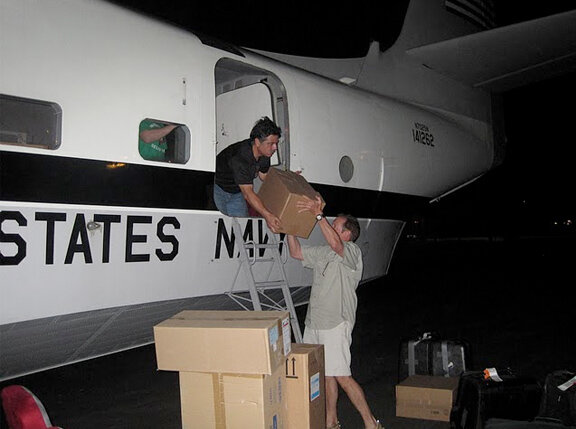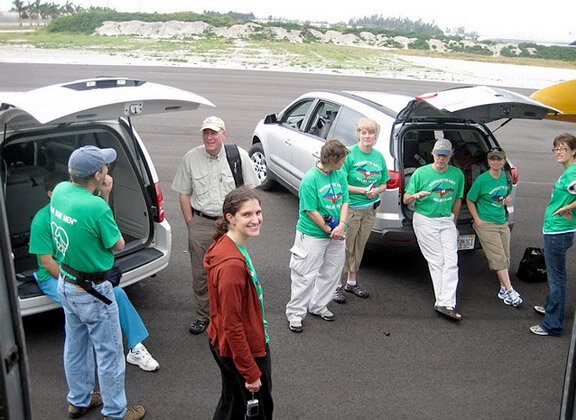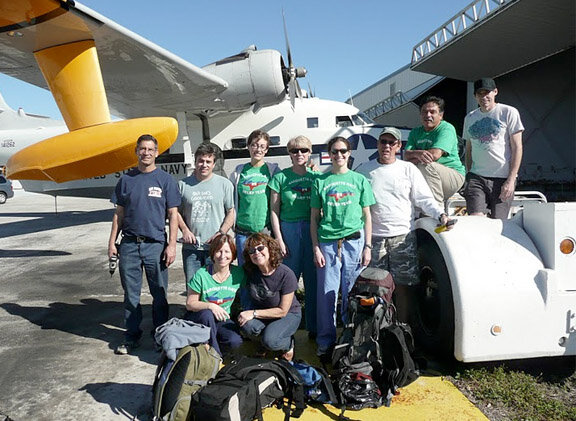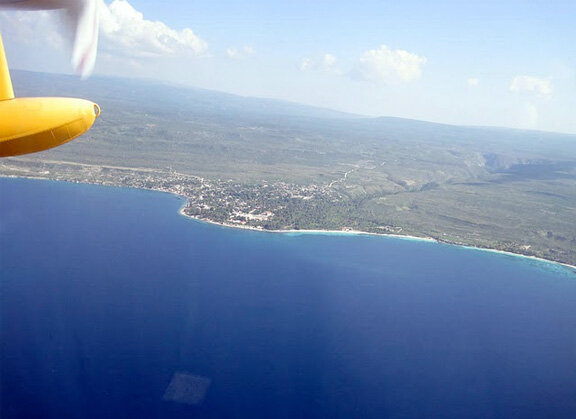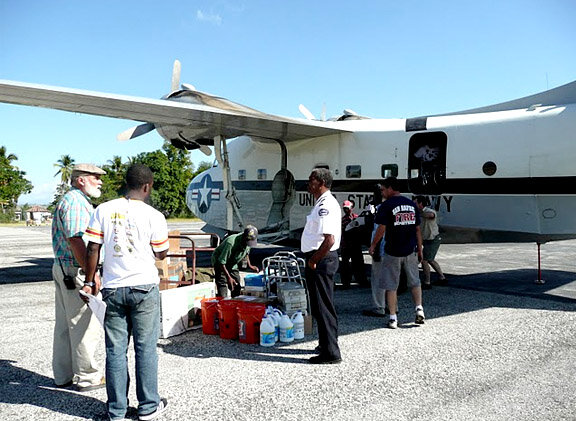ANGEL of MERCY
While Vintage Wings of Canada is dedicated to telling the compelling story of Canada's aviation history by operating the finest collection of flyable aircraft north of the 49th parallel, there are times when we must tell you about stories, aircraft and people that are making a difference in other countries. One story has come to our attention that combines vintage aircraft operations and the most important news story of the day - the earthquake in impoverished Haiti.
In 1949, when Grumman first introduced the HU-16 Albatross amphibious flying boat, it was in the role as an air-sea rescue aircraft - bringing hope and succor to downed Navy and Air Force pilots and aircrew. That was sixty years ago.
Today, only a handful of the original 466 Albatrosses still fly. Quite a few of them, follow the "Cool mon" image started by Parrothead singer-songwriter Jimmy Buffett and are employed in the luxury and marketing roles. Lifestyle companies such as Quicksilver, Red Bull and Billabong utilize their HU-16s as flying brandwagons for clothing and beverages, and Row 44, an in-flight service provider, uses theirs as a flying test bed and marketing platform. All well and good and a great way for an old winged gal to live out her days. But one former US Navy Albatross has put aside her well-earned retirement status and gone back to rescue work on a scale not originally planned for by her original designers.
The Mission
A group of twelve doctors and nurses from Marquette, Michigan, were trying to find a way to get themselves and several tons of donated supplies from the US to Haiti to participate in the relief efforts. The doctors and nurses have partnered with Partners In Health, a long-standing Haitian health provider with an excellent reputation, to man an under-staffed hospital in the Haitian city of Les Cayes.
Their biggest problem was that they had no way to get to or through the crowded Port-au-Prince Airport. Had they gotten there, the state of the roads and the lack of infrastructure would have kept them from contributing to the relief efforts.
This group managed to make contact with long-time Albatross owner and operator, Bill DaSilva. Bill’s plane, US registered N7025N, was already in Florida for the winter. Bill DaSilva quickly agreed to donate their aircraft and time to get these doctors and nurses to their destination, bypassing the usual, blocked relief routes by flying directly to the beach at their destination. Only the Albatross is capable of carrying this load from Miami directly to the waters off of Haiti and returning without refuelling in Haiti. Without this transport, the mission was doomed.
The Grumman HU-16C Albatross (cn G-409) Built in 1955, U.S. Navy# 141262. It was retired from service in 1968. The Albatross was designed to operate unassisted in seas with up to four foot waves. However, with the aid of JATO bottles, it could actually operate in seas of 8-10 feet and occasionally higher. The Albatross is perfect for the role it has taken on in Haiti... bring hope and supplies directly to the coastal cities of the island nation that had endured so much. Photo Kat Fisher
A fine photo of DaSilva's HU-16C Alabtross doing "water work" near Isla Guadalupe, off the Baja Coast of Mexico. The DaSilva family has donated the use of their Albatross for these relief efforts. Bill, a Captain with Delta Airlines, and his wife Gina, a speech pathologist and educator, have spent many hours piloting the Albatross to some of the most exotic places on the planet–including several trips north of the Arctic Circle, to Alaska, and Europe across the North Atlantic. Photo Kat Fisher
The broad-shouldered power of DaSilva's beautiful Albatross is evident in this near head-on photograph. Photos via SeaPlane Operations, LLC
Related Stories
Click on image
The following excerpt is extracted from the Mission's blog. This entry was written by Stuart P. Sarasin and first published in Upper Michigan Source, January 25th, 2010. We thank Stuart and the Albatross Haiti Relief Team for allowing us to share it with you.
"The Marquette Haiti Relief Team arrived in Ft. Lauderdale Saturday after traveling from Marquette, Michigan on Delta Airlines. Over half the team arrived early, with the split of the team necessary due to the large amount of supplies necessary to travel with them. The first group, headed by medical leader Doctor Dan Hardie, went directly to the staging area set up at the Opa Locka airport, near Miami. They met with flight crew leader Bill DaSilva, Delta Airline captain and owner of the Grumman Albatross, and began loading medical supplies on the vintage ex-Navy seaplane, uniquely capable of landing in open sea in waves up to four feet.
The remainder of the group departed Marquette late in the day and arrived in Ft. Lauderdale in the late evening. Additional team member Corinne Baldwin Peimer, daughter of another team member, surgeon Clayton Peimer of Marquette, arrived from Oregon and met with the entire team to make last minute preparations. The early decision to remain fluid in plans and decisions continues to dominate the mission. After several destination hospital locations changed due to changing needs, the number of medical team members able to travel on the first trip was reduced to six, due to the substantial load of medical supplies and uncertain landing conditions in open water off Haiti.
Members of the Marquette medical team unload their gear at the Opa-Locka executive airport near Miami and begin the task of preparing the Albatross for her first mission of mercy to Haiti. Photos via SeaPlane Operations, LLC
Pilot and aircraft owner Bill DaSilva (at door) not only supplied the aircraft and his flying skills, but a lot of sweat equity as he helps the Marquette team load medical supplies aboard his beloved Albatross. Photos via SeaPlane Operations, LLC
Ray Wolfe inspects the port engine of the HU-16C while maintainers begin filling the oil tanks 2.5 gallons at a time after fuelling the flying boat with over 1000 US gallons of high octane avgas. The Grumman Albatross is the only aircraft that can make the return trip from Florida to Les Cayes, Haiti with a payload of 4,000 pounds of much-needed supplies. Photos via SeaPlane Operations, LLC
The medical team from Marquette, Michigan gather with excitement before the first mission to Les Cayes. Photos via SeaPlane Operations, LLC
Members of the flight crew and medical team take a moment to pose for a pre-mission photo. Photos via SeaPlane Operations, LLC
Sunday morning, after fueling and final preflight preparations, the giant Albatross taxied out, about to set out on a critical humanitarian relief mission, the sort of duty for which it was originally designed. As a result of the high takeoff weight, the aircraft struggled to become airborne in the hot Florida air, with Captain DaSilva struggling to climb the relief crew to a minimum altitude. The nearly-five hour flight in the vintage craft; loud, slow and with spartan interior, was met with an appreciation for the capability of the ex-Navy aircraft. With vantage points in the cockpit as well as the nose port viewing area, the medical team was able to get a unique view of the Caribbean from an altitude of only 1,000 feet. The sheer weight of the crew and supplies, as well as a strong headwind which reduced the speed of the 140 mph Albatross even further, led to the long flight at such a low altitude. Fortunately, the air was clear and smooth as the temperature in the non-air-conditioned aircraft exceeded ninety degrees.
After a long, slow climb to clear the mountains of western Haiti, the Albatross descended into the area of the port city of Les Cayes. The flight crew completed a reconnaissance inspection of the landing area, flying low over the city and bay selecting a suitable landing site. Activity in the port city was abuzz as the sight of the low-flying Navy seaplane caught the attention of the entire area. The first landing approach was stable and on-target, yet the rush of local boats and canoes into the bay forced a pull-up and return for landing. Fortunately, the small watercraft were separated enough that a landing clearway was available on the second approach. The rough seas and large swells tested the limits of the Albatross and crew, as the aircraft was launched by a swell on the first touchdown, forced again skyward as the veteran seaplane pilot DaSilva used every bit of his experience and ability to wrestle the ship through several more oscillations and high sea waves to safely bring the relief mission to a stop in the turbulent Caribbean sea.
En route to Haiti, the doctors and nurses of the Marquette team settle in for the long flight over the Caribbean Sea. Photos via SeaPlane Operations, LLC
Owner and chief pilot, Bill DaSilva at the controls of his Albatross. DaSilva has put his family's classic flying boat, his time and his heart into the missions to Haiti. But the costs to operate the large warbird at such long ranges are prohibitive and in order to continue these important mercy missions, DaSilva and LeVeque need your help to keep fuel and oil flowing so that the mighty Albatross can continue. If you wish to donate to this worthwhile cause visit the Albatross Haiti Relief Mission website. Photos via SeaPlane Operations, LLC
Copilot Paul LeVeque enroute to Haiti. Paul is a Captain with the San Rafael, CA, Fire Department, long-time Albatross mechanic, restorer and pilot. Paul has restored some of the most significant Albatrosses still flying, including the Red Bull Albatross and Dr. Richard Sugden’s N3HU. Paul also instructs USAF and US Navy Test Pilot School Students in Albatross flying. Photos via SeaPlane Operations, LLC
DaSilva and LeVeque make their approach to the coast of Haiti. Photos via SeaPlane Operations, LLC
A look over DaSilva's shoulder at the bleak landscape of Haiti. Prior to the devastation brought to the island by the 7+ magnitude earthquake, the landscape of Haiti was scraped clean of its tropical forests by concessionaires logging its precious trees to supply the Haitian demand for charcoal (most Haitians are too poor for electric or gas cooking). In 1954, Haiti was raked by Hurricane Hazel, downing much of the already diminished forests. The following year, concessionaire loggers stepped up the denuding of their paradise... cutting down any hope that they could take part in the tourist boom of the 1980s and 90s. In 1923, 60% of Haiti was shaded by palms and forest. Today, less than 2% of their once-beautiful island is forested. Photos via SeaPlane Operations, LLC
En route to Les Cayes, DaSilva and LeVesque overfly the wasteland that was once a tropical paradise. The deforestation and subsequent erosion are just two in the endless line-up of plagues that have befallen this, the poorest nation in the Western Hemisphere. Photos via SeaPlane Operations, LLC
The serenity of the long, scenic flight was exploded by the flurry of activity that met the crew as they attempted to approach the shore and anchor in the bay. With thousands of local residents rushing to the shore, many jumping into the bay and swimming toward the strange site that was the ex-Navy Albatross, as well as dozens of small watercraft approaching the sturdy yet surface-fragile aircraft, the team members struggled to communicate to the non-English speaking residents to remain clear of the aircraft and especially not allow small canoes and boats to puncture the aircraft's skin. Fortunately, with a combination of local residents' slight understanding of English and Dr. Dan Hardie's usable command of the Creole language, improved greatly by his bushing up by studying the Creole dictionary on the 5-hour flight, minimal order was achieved as the self-contained dinghy was inflated and Dr. Hardie and two team members made their way to shore. The U.N. security force, luckily having a presence in Les Cayes, was able to set up a security perimeter with their significant numbers and allow the off-load of crew and supplies from the relief ship. The transfer of the entire cargo load was arduous at best in the rough sea waters, as concern mounted over the possibility of damage to the craft from the local boat that was offered for assistance. Fortunately, the load was safely transferred and the last of the crew boarded the ancient, but sturdy, boat.
Local residents crowd a pier at Les Cayes to welcome and watch as the massive flying boat prepares to leave after dispatching its supplies and people... right where they were needed. Photos via SeaPlane Operations, LLC
Children in a wooden dugout watch as a small zodiac inflatable ferries people and supplies to shore at Les Cayes. Photos via SeaPlane Operations, LLC
The flight crew wasted no time in preparing the Albatross for take-off, as the team members on the ground coordinated with local residents to clear the take-off lane. DaSilva and the flight crew of three battled the high waves and turbulent sea to return the aircraft to a more natural element as they lifted off the water and began the long return flight to South Florida. DaSilva would later describe the entire experience in a single phrase, exclaiming, "That was sporting!"
Meanwhile, the initial medical team members were met with a hero's welcome as hundreds of local residents, many children, rushed to the streets to catch a glimpse of the spectacle. Cheers went up as the crew rounded every turn, slowly making their way to the Hopital Immaculee Conception (Hospital Immaculate Conception) to meet up with the local medical staff. Back at the landing site the remainder of the crew awaited further instructions and made friendships with the much-appreciative locals. Handshakes and smiles were evident throughout the crowd as the battered yet resilient Haitian locals greeted the relief members. After the crew was re-assembled they conducted a tour of the facility and supplies and began plans for the week-long mission, on what will assuredly prove to test the limits of supplies and equipment as the dedicated crew of doctors and staff prepare to supply aid to a ravaged country by helping residents of this Haitian port city.
During preparations for the mission, members' health was a concern as proper immunizations and anti-malaria medication was provided as well as provisions for sleeping in infested areas - plastic sheeting, special bedding and mosquito nets - as well as means of purifying drinking water. Fortunately, former Upper Peninsula residents Virginia and John Bell, who live in the port city of Les Cayes and still spend part of the year in Paradise, Michigan, operate the Belle Maison, a secure home for volunteers working with the mission Centre International de Recherche et d'Action pour le Developpement Durable, or CIRADD. The Bells graciously offered their home to the entire relief mission, providing sleeping quarters, sanitary conditions and food throughout the week. The Bells are keeping close contact with their daughter, Jayme Bell, an elementary music teacher in the Marquette School District. Additionally, local resident Jean Michelle Baquin, a local Les Cayes resident, is proving to be invaluable in providing information, translation and coordination efforts with the relief team and local medical officials. Baquin had to opportunity to study in the United States, a result of the support of the local missionary. Baquin's diverse study included opportunities in Iowa, Illinois and South Dakota. Baquin holds a P.H.D. and returned to his home town, struggling to bring significant change to the infrastructure of Haiti.
As the medical team settled in, the flight crew continued the challenge of the entire mission as they made their way back to Florida, now proceeding in the ever darkening skies of the Caribbean. The strong headwinds suffered during the flight to Haiti necessitated a fuel stop in the Turks and Caicos Islands. After refueling, the Albatross lumbered into the sky once again, but shortly after takeoff, enroute to Florida, the aircraft suffered an electrical failure which affected the navigation gyro instruments, and, additionally, had a warning light that led to a forced landing in Nassau, the Bahamas. The crew spent the night, repaired the electrical problem and headed back to Ft. Lauderdale. Plans are under way to facilitate the transport of the remaining supplies and medical crew aboard the Albatross to Les Cayes, hopefully Monday afternoon.
Monday, the medical team is exhaustively working under extremely difficult conditions and a lack of supplies and proper tools to provide emergency medical care to patients, some severely injured in the earthquake and waiting nearly two weeks with multiple fractures and injuries that have gone untreated, with little or no attention to injuries and often times no available pain medication. The team will work long into the evening, perhaps through the night, as the remaining crew members anxiously await their opportunity to join their team and provide additional care and support
Bill DaSilva overflies Les Cayes, Haiti obscured by smoky fires and haze. Photos via SeaPlane Operations, LLC
Joe Duke and Ray Wolfe load wheelchairs, crutches and other orthopaedic supplies for the people of Les Cayes before the second mission. Photos via SeaPlane Operations, LLC.
Unloading supplies and meeting in-country contacts at the Les Cayes airport due to heavy seas that prevented a water landing. Photos via SeaPlane Operations, LLC
Linda LeVeque, wife of copilot Paul LeVeque distributes some goodies to children at the fence line of Les Cayes Airport. Photos via SeaPlane Operations, LLC.
The return trip from the first mission flight to Les Cayes, did not go routinely as an electrical malfunction was followed by an indicator light that predicted a problem with one of the huge radial engines. A forced landing was made in Nassau the Bahamas. An inspection revealed no indications that the engine suffered any damage or malfunction and, thus, a faulty light was suspected. Repairs were made to the electrical system and the flight crew returned the Albatross to Ft. Lauderdale. The aircraft was refueled and serviced for the next flight and the supplies and team members were loaded. The relief flight lifted off to begin the four-hour flight, however, shortly after takeoff the same warning light illuminated. Not able to assume a faulty light, the flight was forced to return to the airport and the flight was scrubbed. Repairs were again made and a test flight is planned for early morning. Pending a successful test, the team will again load up and depart for Les Cayes, hopefully arriving prior to noon.
The Albatross casts a distinctive and identifiable shadow as she flies over one of the many tent cities set up amidst the devastation of Haiti - symbol of the need and the hope that is the Haiti Albatross Relief Mission. Photos via SeaPlane Operations, LLC
Post Script: The Canadian Albatrosses
And now for the Canadian angle. In the 60s the Royal Canadian Air Force operated ten Grumman Albatross aircraft in the rescue role, some of which they had configured in a uniquely Canadian manner - as "tri-phibians" - usable on water, runways and snow. This consisted of two removable, outrigger skis and large 2-part fuselage ski, of which, the rear portion could be removed in summer and replaced by a flat insert. Photo: DND
A nice photograph of an RCAF Albatross with long range tanks. The life history of 9303 according to R.W.R Walker's excellent Canadian Military Aircraft Serials is as follows: Served with 102 Composite Unit (KU), RCAF Station Trenton, Ontario, as well as with 103 KU, RCAF Station Greenwood, Nova Scotia, and finally with No. 413 (Rescue) Squadron out of CFB Summerside, Prince Edward Island. In storage by 1 December 1970. Sold to Grumman on 19 August 1971, refurbished and re-sold. Registered as N9427. Delivered to Chilean Navy on 1971. Transferred to FACH, their serial number 573, later 273. Retired in 1979, sold to Malaysia as M35-01. Currently on display at Kuala Lumpur in the RMAF Museum. Also reported on US register as N8487H, dates not known. Photo: DND
A trio of RCAF Albatross aircraft practice a little extreme low-level formation flying. The aircraft in the foreground is Albatross 9304. On his birthday in 1966, MGen (Ret'd) Bob Fassold, had a birthday ride in this particular Albatross. Bob remembers that the mid-lake swells were over well over 6 feet and the landing was done in a very peculiar way. The Albatross was flown in for a landing at wave-top level skimming the crests and at the right moment, the engines were reversed (or rather the props were feathered and then brought to reverse pitch) and the aircraft seem to stop dead in the air and fall the final few feet into the trough. The captain was F/L Durrant and the copilot was F/O Manley. The rough water landings were in Picton Bay, near the Albatross's home base at Trenton on Lake Ontario. Photo: DND









